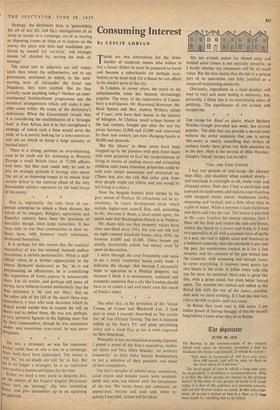Consuming Interest
By LESLIE ADRIAN THERE are two alternatives for the town- dweller of moderate means who wishes to buy a house. Either he must be prepared to travel and become a suburbanite (or perhaps exur- banite) or he must look for a house he can afford in the shadier parts of the city.
In London, in recent years, the move to the unfashionable areas has become increasingly popular. The story of the rediscovery of Canon- bury is well known. Mr. Raymond Mortimer, Mr. Basil Spence and Mrs. Audrey Withers, editor of Vogue, now have their homes in the enclave of Islington. In Chelsea, small artisan houses of the last century, bought just after the war for prices between £2,000 and £3,000 and renovated by their new owners, are now changing hands at £6,000 and upwards.
But the 'plums' in these areas have been snapped up by the pioneers with pink front doors who were prepared to face the inconvenience of living in streets of peeling stucco and screaming children until more tenement properties could be sold with vacant possession and smartened up. (There was also the risk that other pink front door people might not follow and you would be left living in a slum.) Now the bargain hunters have turned to the grey streets of Pimlico. Its attractions are its ac- cessibility, its future development plans which include higher-rent council flats, and, according to Mr. Dawson S. Bunn, a local estate agent, the social note that Buckingham Palace is in Pimlico.
Mr. Bunn tells me that property values have risen one-third since 1951, but you can still buy an eight-roomed leasehold house, circa 1850, for between £4,000 and £5,000. These houses are usually structurally sound, but money must be spent on decoration.
I drive through the area frequently and seem to see a newly smartened house every week. I welcome the change. Not because I personally hope to speculate in a Pimlico property, but because I think it is unnecessary, outdated and economic nonsense that a city like London should have in its centre a sad and seedy area like much of Pimlico today.
The other day, at the invitation of Mr. Victor Crosse, of Crosse and Blackwell Ltd., I took part in what I recently described as 'the mystic rite' of Ten O'Clock Testing. The test is featured widely in the firm's TV and press advertising today and a clock face at ten is even engraved on their letterhead.
Promptly at ten, my breakfast scarcely digested. I joined a panel of the firm's executives, techni- cal chiefs and Mrs. Olive Mander, 'an ordinary housewife,' at their Soho Square headquarters to test a selection of their products and those of their competitors.
The day's samples of tomato soup, consommé, salad • cream and tomato sauce were unidenti- fiable and were not named until the completion of the test. We wrote down our comments on appearance, texture and taste and, when re- quired, I was told, 'action will be taken.' My ten o'clock palate for tinned soup and bottled salad cream is not specially sensitive, so I doubt whether my comments will be of much value. But the firm insists that the test is a serious part of its operations and fully justified as a means of maintaining standards.
Obviously, ingredients in a food product will tend to vary and some testing is necessary, but, primarily, I think this is an enterprising piece of publicity. The significance of ten o'clock still escapes me.
* * THE recipe for Bceuf en daube, which Barbara Worsley-Gough 'provided last week, has proved popular. The dish that can provide a second meal without the awful suspicion that one is eating 'left-avers' is clearly something that writers of cookery books have given too little attention to in the past. Here is the second of Miss Worsley- Gough's 'linked' recipes. Let us call it
VEAL AND FISH UNITED
I buy two pounds of veal scrag—far cheaper than fillet, and excellent when cooked slowly— and marinade it overnight in oil, white wine and chopped onion. Next day I buy a sea-bream and a pound of mushrooms, and make a court bouillon with chopped onion, carrot, mushroom stalks, seasoning and bayleaf, and a little white wine in a pint of water. While it simmers I scale the bream and drain and trim the veal. The bream is poached in the court bouillon for twenty minutes, then I flake off the flesh and return the skin and bones, reduce the liquid to a fume: and strain it. I heat two spoonfuls of oil with a crushed clove of garlic in a pan, the veal is lightly saute and removed to a buttered casserole, then the marinade is put into the pan, the mushrooms cooked in it for a few minutes, and the contents of the pan turned into the casserole, with seasoning and enough futnet to cover everything. It simmers most gently for two hours in the oven. It jellies when cold (the top fat must be removed then) and is good like this, with a green salad, but even better heated again. The remains are melted and added to the flaked fish with the rest of the fumet—another dish with no more cooking. If I had the veal hot, 1 have the fish en gelee, and vice versa.
In Rome they cook veal in fish sauce. I am rather proud of having thought of this for myself long before I knew what they do in Rome.


































 Previous page
Previous page